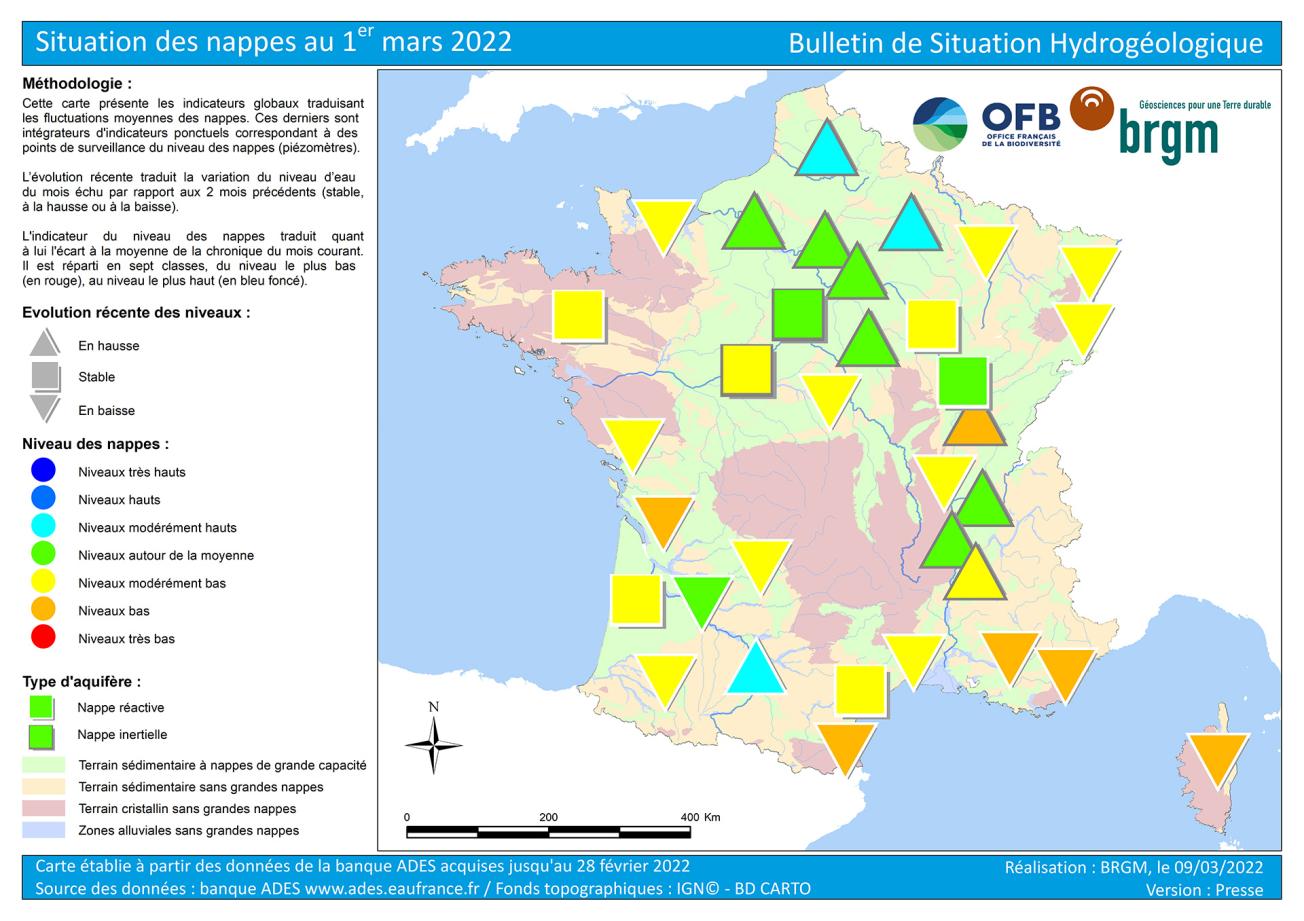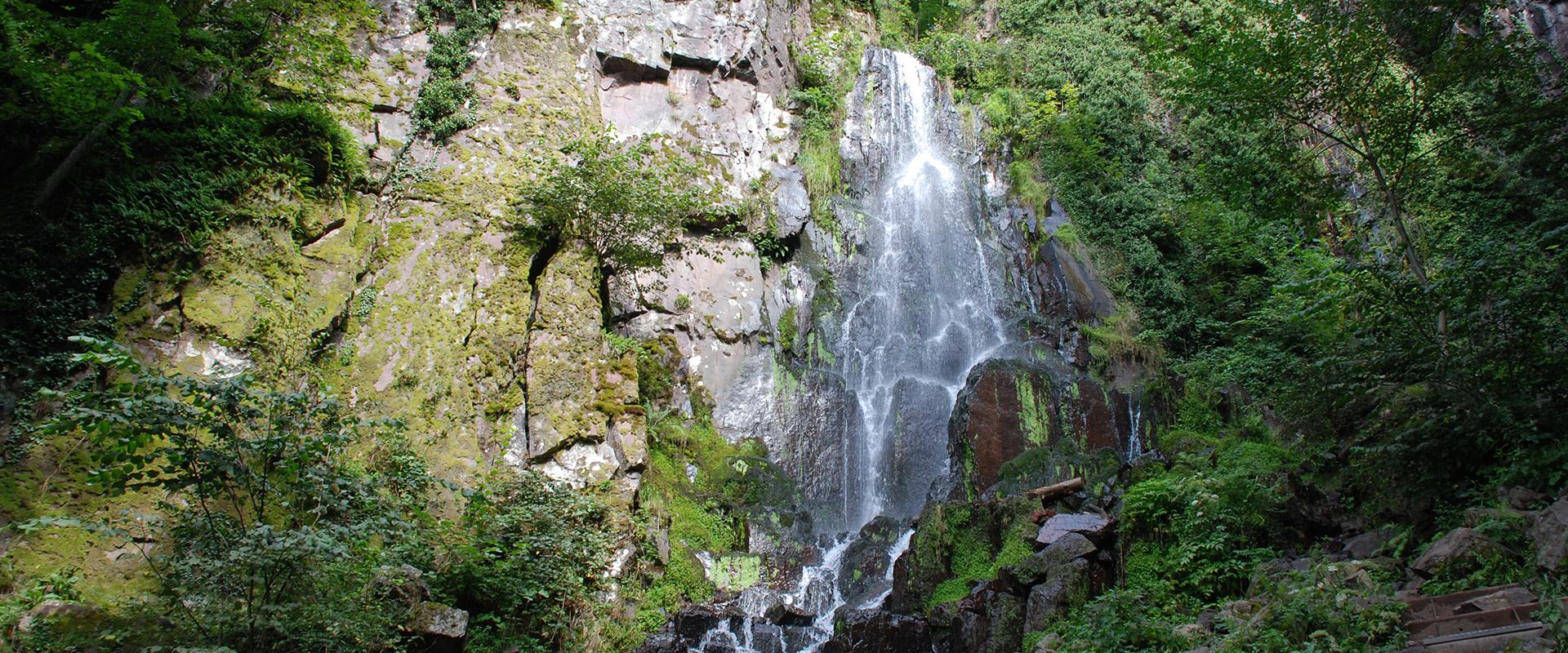
Map of water table levels in France on 1 March 2022.
© BRGM
Hydrogeological situation on 1 March 2022
The lack of effective rainfall from January onwards reversed the trends observed previously. The levels of reactive aquifers are generally decreasing. The inertial aquifers are still rising or stable but the recharge has slowed considerably.
While the low water period in autumn 2021 was not too severe, the situation in February was unsatisfactory, with levels ranging from being comparable to monthly averages to low. This is due to the 2021-2022 recharge being relatively limited so far, resulting in a deterioration of the situation during the month of February. The only aquifers in which more positive levels can be observed are the inertial aquifers in the Paris Basin, the Artois-Picardy Basin and in the fluvio-glacial formations of the Rhône basin. Here, the levels range from being close to monthly averages to high.
The trends in March will essentially depend on the amount of rainfall. The recharge could resume in areas with a lot of rainfall, meaning the situation might then improve. If there is insufficient rainfall, the depletion could continue in the reactive aquifers and even spread to the inertial aquifers. The state of the water tables would then continue to deteriorate. The situation needs to be closely monitored in all the reactive aquifers, in the Beauce limestone inertial aquifer and in the inertial aquifers of the Rhône-Saône corridor.
Groundwater trends
The recharge period started during October 2021 in south-east France. It started late in the rest of the country; during November for reactive aquifers and during December as regards the inertial aquifers in the Paris Basin. In December and January, recharge remained active with overall levels increasing. The month of February was marked by a considerable lack of effective rainfall. In February, the trends in water-table levels were variable, as they depend on the reactivity of the aquifers and the amount of local rainfall.
Reactive aquifers are sensitive to meteorological phenomena and are rapidly affected by the lack of significant rainfall. In February, the trends in most of the reactive aquifers were reversed and levels decreased again. The effective rainfall in February was sufficient to recharge the aquifers in some areas. Consequently, stable or rising levels were recorded in the south-west (Aquitaine Plio-Quaternary aquifer, alluvial aquifers in the upstream area of La Garonne and its main tributaries, alluvial aquifers on the Languedoc coast), in the west (Armorican basement aquifers) and in the north-east (Jurassic limestone aquifers of the Côte-des-Bars and the alluvial aquifers of Bourgogne-Franche-Comté). However, these increases in levels were often the result of small, effective rainfall events that caused very short-term recharges.
The levels of the inertial aquifers in the Paris Basin and the Rhône-Saône corridor continued to rise or remained stable. The rainfall that has been filtering through the ground since the beginning of the autumn is moving very slowly through the unsaturated zone to reach these aquifers. The increases in the levels recorded in February were therefore due to the effective rainfall during the previous months. However, the recharge slowed down considerably during February and levels seem to be stabilising in some areas.
Situation in relation to February averages
The majority of the aquifers across France did not experience a particularly severe low-water period in 2021, apart from in the south of the country. The rainfall at the beginning of the recharge period helped maintain a generally satisfactory situation until January 2022. In February, the recharge was insignificant or non-existent. Consequently, the situation of the aquifers deteriorated compared to January, particularly in the reactive aquifers.
In February, reactive aquifer levels were generally lower than normal for the month, ranging from moderately low to low. Locally, very low levels were noted in the Cenomanian sand aquifer in Maine, in the Jurassic limestone aquifer in the south of the Vendée, in the Cretaceous limestone aquifers in Périgord and the Angoumois basin, and in the multi-layer aquifer in Roussillon.
As regards the inertial aquifers in the north of France, the situation deteriorated slightly during February. Levels remained satisfactory ranging from average to moderately high. However, it should be noted that low levels were recorded in the Beauce limestone aquifer.
The situation in the inertial aquifers in the Rhône-Saône corridor was varied and less positive, with levels ranging from being close to monthly averages to low. Locally, levels were very low in the Plio-Quaternary gravel aquifer in Bourgogne-Franche-Comté and in the Miocene molasse aquifer in Bas-Dauphiné.
Several aquifers remained in a positive situation, with levels ranging from moderately high to high in relation to the levels recorded for February in previous years:
- The levels in the Champagne Chalk and Artois-Picardy basin inertial aquifers remained moderately high and the recharge was still active, although slower;
- The alluvial aquifers in the upstream area of La Garonne and its main tributaries did not experience a particularly severe low-water period and benefited from a recharge that continued in February. Consequently, their levels remained moderately high.
A less positive situation was observed in certain aquifers, whose levels were moderately low (or even low to very low, in some areas) compared to February averages:
- The levels in the Cretaceous limestone aquifers in Périgord and the Angoumois basin were low, since the recharge period started late and did not last long;
- The levels in the Plio-Quaternary gravel inertial aquifer in Bourgogne-Franche-Comté were rising but remained low, due to the low recharges of the previous winters;
- The situation in the Jurassic limestone, Tertiary-formation and alluvial aquifers in Corsica, Provence and Roussillon deteriorated due to the low recharge in 2021-2022, and levels remained low.
Forecasts
Météo-France's forecasts are hardly optimistic: from March to May 2022, the forecasts are for warmer and drier-than-normal weather. The rise in temperatures, the regrowth of vegetation and therefore the increase in evapotranspiration will clearly reduce rainfall infiltration over the next few weeks.
If there is insufficient rainfall, the depletion could continue in the reactive aquifers and quickly spread to the inertial aquifers. The state of the water tables would then continue to deteriorate.
Nevertheless, in March, the recharge could resume in areas with a lot of rainfall, meaning the situation might then improve. From April onwards, recharge episodes will probably be occasional and not particularly intense, unless there are exceptional episodes of rainfall.
If the beginning of the depletion period is indeed confirmed, the recharge period will have been extremely short (November to January) and moderate. This could result in difficult situations as of spring. The situation needs to be closely monitored in all the reactive aquifers, in particular in the Cenomanian sand aquifer in Maine, in the limestone aquifers in the north of the Aquitaine Basin and in the aquifers in the south-east of France, which remain in a vulnerable state due to the fairly severe low-water period last summer. The inertial limestone aquifer in the Beauce region, the Plio-Quaternary gravel aquifer in Bourgogne-Franche-Comté and the Miocene molasse aquifer in Bas-Dauphiné also need to be closely monitored.
Hydrological Status Report
The national hydrological status report consists of a set of maps with corresponding comments that show the monthly evolution of water resources. It describes the quantitative situation of aquatic environments (effective rainfall, river discharge, groundwater table levels, reservoir-dam filling status) and provides summary information on Prefectoral Orders issued to limit water use during the low-water period.
Press contact








